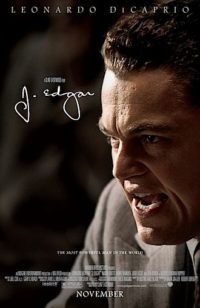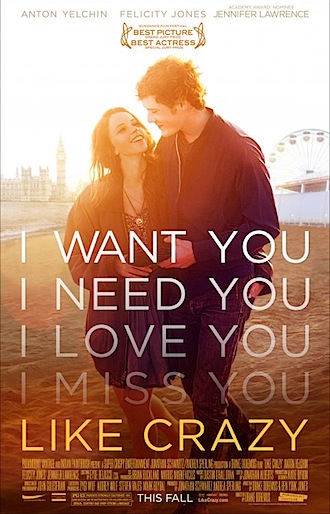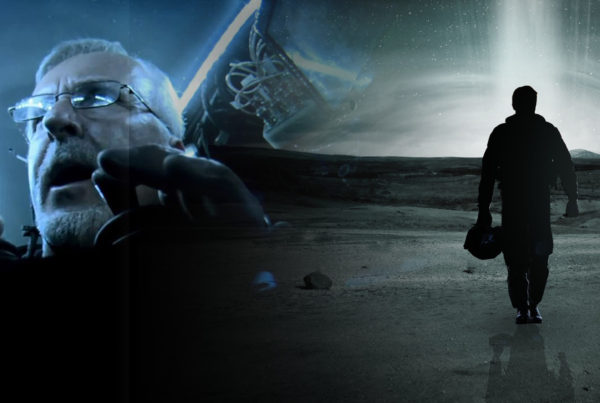 Three films this week point the way towards possible futures for cinema – and if two of them are right then we should all find another hobby. Like Crazy is a mostly-improvised romance shot on one of those pro-am stills cameras that can also shoot hi-def video (the Canon 7D in this case). These devices are affordable and highly portable but the look that they have, while effective in music videos and short sequences, doesn’t keep your interest over the length of a full feature. And, just because your camera lets you shoot a lot of footage of people noodling around making stuff up, that doesn’t mean you shouldn’t still have an actual plan.
Three films this week point the way towards possible futures for cinema – and if two of them are right then we should all find another hobby. Like Crazy is a mostly-improvised romance shot on one of those pro-am stills cameras that can also shoot hi-def video (the Canon 7D in this case). These devices are affordable and highly portable but the look that they have, while effective in music videos and short sequences, doesn’t keep your interest over the length of a full feature. And, just because your camera lets you shoot a lot of footage of people noodling around making stuff up, that doesn’t mean you shouldn’t still have an actual plan.
Actually, the photography is less of a problem in Like Crazy than the story: two young lovers not so much star-crossed as US Department of Immigration-crossed, have to decide how much they care for each other when their efforts to be together are thwarted by the pesky Atlantic ocean and their own shallowness. Felicity Jones (Chalet Girl ) is the Brit who overstays her student visa so she can be with Californian furniture designer Anton Yelchin (Fright Night), setting the wheels in motion that will actually keep them apart for years.
Self-absorbed, self-entitled and selfish, both these characters are very hard to warm to and the actors’ efforts at improvisation only reveal that they don’t have very much to say and no interesting way to say it. Like Crazy won the big prize at Sundance last year and if this is the future it’s a very dull one.
 Another kind of digital cinema project is the found-footage genre where our feature film is made up of artfully recreated handicam, security cam, youtube, cellphone, etc material assembled after the fact to tell a – usually creepy – story. The Blair Witch Project started this off years ago and at its worst you get Paranormal Activity and its best you find a surprise like Chronicle. In it, three high school pals discover a mysterious buried meteorite that gives them super powers.
Another kind of digital cinema project is the found-footage genre where our feature film is made up of artfully recreated handicam, security cam, youtube, cellphone, etc material assembled after the fact to tell a – usually creepy – story. The Blair Witch Project started this off years ago and at its worst you get Paranormal Activity and its best you find a surprise like Chronicle. In it, three high school pals discover a mysterious buried meteorite that gives them super powers.
After fooling around with their telekinesis for a bit, things turn sour when repressed young Andrew (Dane DeHaan) starts taking his frustration out on his many tormentors. The plot reminds me of De Palma’s classic Carrie but Chronicle is less creepy and more propulsive. Some of the set-pieces are brilliant – particularly the unexpected arrival of a passenger jet while the chums are practicing their flying – but the found footage device seems to require constant explanations which dropped me out of a story which was working. I wonder whether it was really necessary or would Chronicle have worked just as well told straight?
 The other trend I wish to see no more of is the gratuitous and repulsive boorish lads on holiday film. The first Hangover was terrific but the returns have been poor since then and A Few Best Men is right down there with The Inbetweeners Movie in portending the decline of Western civilisation. Three imbeciles visit Australia for their friend’s wedding and ugly stereotypes and cheap non-jokes ensue. If you sit through A Few Best Men until the end then we can’t be friends.
The other trend I wish to see no more of is the gratuitous and repulsive boorish lads on holiday film. The first Hangover was terrific but the returns have been poor since then and A Few Best Men is right down there with The Inbetweeners Movie in portending the decline of Western civilisation. Three imbeciles visit Australia for their friend’s wedding and ugly stereotypes and cheap non-jokes ensue. If you sit through A Few Best Men until the end then we can’t be friends.
 The amount of interest you might have for Clint Eastwood’s solid biopic of J. Edgar Hoover will entirely depend on how much interest you have for the subject matter – the film doesn’t manage to transcend it despite the obvious care and attention that went in. Leonardo DiCaprio plays the famous G‑Man through all stages of his life which means he spends almost half the movie smothered in that latex old man makeup which – while the best I’ve seen – is almost impossible to act under. His voice isn’t that of an old man either, which doesn’t help.
The amount of interest you might have for Clint Eastwood’s solid biopic of J. Edgar Hoover will entirely depend on how much interest you have for the subject matter – the film doesn’t manage to transcend it despite the obvious care and attention that went in. Leonardo DiCaprio plays the famous G‑Man through all stages of his life which means he spends almost half the movie smothered in that latex old man makeup which – while the best I’ve seen – is almost impossible to act under. His voice isn’t that of an old man either, which doesn’t help.
Several other fine performers are wasted in supporting roles, particularly the thankless women in his life – Judi Dench plays a domineering mother and Naomi Watts is his self-sacrificing life-long secretary. The biggest issue with J. Edgar, to my mind, is that it has to choose whether it is a political biography or a personal one – and it makes the less interesting choice.
Hoover was clearly a well-closeted and probably unacknowledged homosexual but he was also one of the most powerful men in America. The real world impact of his meddling in affairs of state is glossed over in favour of a more intimate portrait of a private life that wasn’t so unusual for the period. The film is also fairly sympathetic to the authoritarian old brute.
 Spanish genre pics are always worth a look and Julia’s Eyes is a fine example. It’s a Guillermo Del Toro-produced horror flick about twin sisters (Belén Rueda) with the same deteriorating eye condition. Sara carks it mysterious circumstances before the credits have even rolled, and it’s up to Julia to solve the puzzle before her own sight disappears. The truth turns out to be fairly convoluted but by the time it is revealed you should be hooked by Guillem Morales tense direction which is spoiled only by a couple of gross moments that I don’t think the film needed.
Spanish genre pics are always worth a look and Julia’s Eyes is a fine example. It’s a Guillermo Del Toro-produced horror flick about twin sisters (Belén Rueda) with the same deteriorating eye condition. Sara carks it mysterious circumstances before the credits have even rolled, and it’s up to Julia to solve the puzzle before her own sight disappears. The truth turns out to be fairly convoluted but by the time it is revealed you should be hooked by Guillem Morales tense direction which is spoiled only by a couple of gross moments that I don’t think the film needed.
Printed in Wellington’s Capital Times on Wednesday 8 February, 2012.



